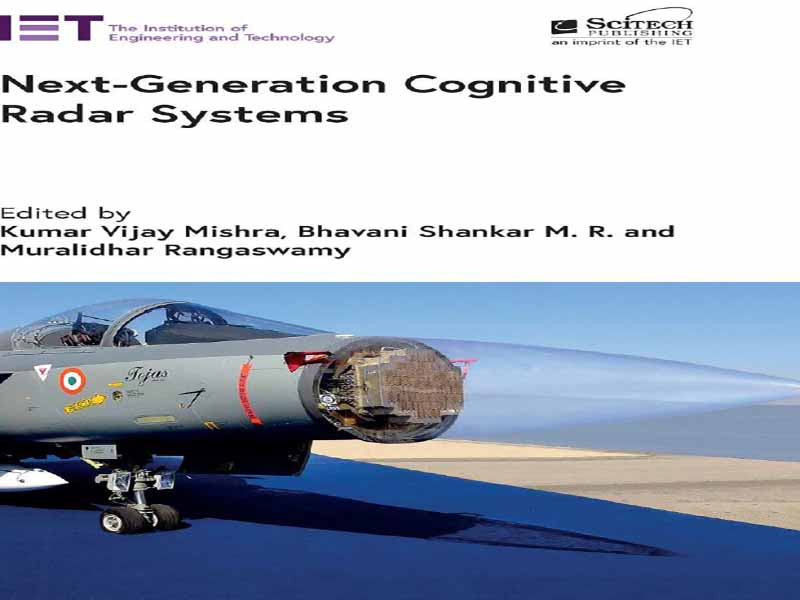- عنوان کتاب: Next-Generation Cognitive Radar Systems
- نویسنده: Kumar Vijay Mishra
- حوزه: رادار
- سال انتشار: 2024
- تعداد صفحه: 685
- زبان اصلی: انگلیسی
- نوع فایل: pdf
- حجم فایل: 9.15 مگابایت
عنوان این کتاب در ابتدا «فراتر از رادار شناختی» بود. اما با مشورت و بحثهای بیشتر، آن را به «سیستمهای رادار شناختی نسل بعدی» تغییر دادیم. این عنوان، در اصل، تحقیقات پرشور و مداوم در مورد سوالات نظری مختلف و فناوریهای توانمندساز برای رادارهای شناختی را در بر میگیرد. در طول دو دهه گذشته، معرفی شناخت در رادار، عصر جدیدی از طراحی و مهندسی سیستم رادار را نوید داده است. این سیستمها با بهینهسازی همزمان پردازش ارسال و دریافت در پاسخ به تغییرات در محیط هدف، قابلیتهای حسگری پیشرفتهای را ارائه میدهند. تحقیقات در مورد رادارهای شناختی با ارائه کنترل بیشتر بر فرستندهها و سازگاری بالاتر گیرندهها نسبت به همتایان غیرشناختی خود، فرصتهای منحصر به فردی را در طیف وسیعی از کاربردهای غیرنظامی و دفاعی آشکار کردهاند. در قلب رادار شناختی، این سوال کلیدی نهفته است: اگر یک رادار با یک مدل شناختی معقول تجسم یابد، آیا با اهداف و سایر موجودات دارای شناختی مانند شناخت انسان تعامل خواهد داشت؟ این امر مستلزم درک مدل شناختی خود انسانها است که خود یک حوزه تحقیقاتی فعال نوروبیولوژیکی است. به طور کلی، طبقهبندی بنجامین بلوم که در دهه ۱۹۵۰ ارائه شد و انواع آن، معیارهایی برای طبقهبندی تواناییهای شناختی مختلف انسان در نظر گرفته میشوند. شناخت در سیستمهای بیسیم خود زیر چتر وسیع سیستمهای سایبرفیزیکی شناختی قرار میگیرد، که در آن یک ماشین مجهز به قابلیتهای شناختی شبیه به انسان است که پایه و اساس تعاملات انسان و ماشین را فراهم میکند. در حالی که ردیابی منشأ اصطلاح “سیستمهای شناختی” دشوار است، نزدیکترین همتای آن “سایبرنتیک” توسط نوربرت واینر در سال ۱۹۴۸ ابداع شد. هالناگل و وودز اولین کسانی بودند که سیستمهای شناختی را به طور مفصل در مقاله خود در سال ۱۹۸۳ با عنوان “مهندسی سیستمهای شناختی: شراب جدید در بطریهای جدید” که در مجله بینالمللی مطالعات انسان و ماشین منتشر شد، توصیف کردند. این اصطلاح به سرعت رواج یافت و سرانجام در مقاله سال ۱۹۹۹ با عنوان “رادیو شناختی: شخصیتر کردن رادیوهای نرمافزاری” نوشته میتولا و مگوایر که در مجله ارتباطات شخصی IEEE منتشر شد، به رادیو شناختی راه یافت. پس از آن، پیشرفتهای اولیه در رادارهای شناختی، ایدههای ادبیات رادیو شناختی اوایل دهه ۲۰۰۰ را دنبال کرد. با این حال، الزامات و گزینههای طراحی کاملاً متفاوت و مختص به هر کاربرد، منجر به ظهور مفهوم رادارهای شناختی به عنوان یک موضوع تحقیقاتی مستقل و پربار در اواسط دهه 2000 شد. مقاله برجسته سیمون هیکین در سال 2006 با عنوان “رادار شناختی: راهی برای آینده” که در مجله پردازش سیگنال IEEE منتشر شد، به همراه کتاب جوزف گورسی در سال 2010 با عنوان “رادار شناختی: رویکرد کاملاً تطبیقی با کمک دانش” (چاپ دوم در سال 2020)، زمینه مفهومی بسیاری از کاربردهای اولیه را فراهم کرد. امروزه، با گسترش حسگری برای انجام وظایف مختلف در بسیاری از کاربردهای جدید مانند رادار خودرو، محیطهای هدف دیگر به اندازه محیطهای مورد توجه در رادارهای شناختی اولیه بیخطر نیستند. علاوه بر این، رادارهای شناختی مرسوم با چالشهای متعددی نه تنها در انتزاع هوشمند دادههای دریافتی در زمان واقعی، بلکه در تطبیق تکنیکهای حسگری با یک محیط بسیار پویا و پیچیده نیز مواجه هستند. برای پرداختن به چالشهایی فراتر از رادارهای شناختی مرسوم، علاقه زیادی به بهبود، فعالسازی و مهندسی روشهای پردازش نوین برای دستیابی به سطوح پیچیدهتر شناخت وجود داشته است. برای تجهیز متخصصان رادار به ابزارهای پیشرفته برای نسل بعدی سیستمهای رادار شناختی بسیار پیچیده، ما مفتخریم که این کتاب را که توسط موسسه مهندسی و فناوری (IET) منتشر شده است، ویرایش کنیم. این کتاب در مجموعه معتبر SciTech/IET در مورد رادار، الکترومغناطیس و فناوریهای پردازش سیگنال قرار دارد. این کتاب با هدف گردآوری مشارکتهای محققان برجسته و واجد شرایط که در خط مقدم تحقیق و توسعه تواناییهای شناختی نسل بعدی در مهندسی رادار مشغول به کار هستند، نوشته شده است. در حال حاضر چندین کتاب عالی در مورد رادارهای شناختی (به عنوان مثال، نوشته سیمون هایکین و جوزف گوئرسی) وجود دارد که بینشهایی در مورد تحقق رفتار بهینه و تطبیقی در حوزه شناخت کلاسیک در رادارها ارائه میدهند. با توجه به پیشرفتها و کاربردهای قابل توجهی که در این زمینه در 5 سال گذشته پدیدار شده است – از جمله استفاده از ابزارها/نظریههای جدید مانند یادگیری عمیق، بازسازی پراکنده، بهینهسازی غیر محدب، نظریه بازیها، کنترل تصادفی و نظریه کوانتومی – خود مفهوم شناخت به گونهای اصلاح شده است که اکنون از سطوح شناخت کلاسیک بلوم که تاکنون برای رادارها اعمال شده است، فراتر میرود. از این رو، نیاز است تا مهمترین و موفقترین مفاهیم رادارهای شناختی به شیوهای آموزشی از متخصصانی که خود آن نتایج را توسعه دادهاند، گردآوری شود. این کتاب با در نظر گرفتن بررسی همدلانه و دقیق هر روش شناختی جدید، فراتر از درک سطح بالای مفاهیم جدید میرود. این امر به محققان کمک میکند تا درک عمیقی از رویکردهای شناختی جدید ایجاد کنند.
The title of this book was initially “Beyond Cognitive Radar.” But, on advice and further discussions, we changed it to “Next-Generation Cognitive Radar Systems.” This title, in essence, captures the ongoing frenetic research on various theoretical questions and enabling technologies for cognitive radars. During the past two decades, introducing cognition in radar has heralded a new era of radar system design and engineering. These systems offer advanced sensing capabilities by simultaneously optimizing both transmit and receive processing in response to the changes in the target environment. Research on cognitive radars have revealed unique opportunities in a variety of civilian and defence applications by affording greater control of transmitters and higher adaptability of receivers than their non-cognitive counterparts. At the heart of cognitive radar lies the key question: if a radar is embodied with a reasonable cognitive model, would it interact with targets and other entities with cognition like that of a human. This requires understanding the cognitive model of humans themselves, which is an active neurobiological research area of its own. In general, Benjamin Bloom’s taxonomy proposed in 1950s and its variants are considered benchmarks for classifying various human cognitive abilities. Cognition in wireless systems itself falls under the broad umbrella if cognitive cyberphysical systems, wherein a machine is equipped with a human-like cognitive capabilities that provides the basis for human–machine interactions. While it is difficult to trace the origin of the term “cognitive systems,” its closest counterpart “cybernetics” was coined by NorbertWeiner in 1948. Hollnagel andWoods were the first to describe cognitive systems in detail in their 1983 paper “Cognitive Systems Engineering: New Wine in New Bottles” published in the journal International Journal of Man-Machine Studies. The term quickly gained currency eventually finding its way to cognitive radio in the 1999 paper “Cognitive Radio: Making Software Radios More Personal” by Mitola and Maguire that appeared in IEEE personal communications journal. Thereafter, initial developments in cognitive radars followed the ideas from cognitive radio literature of early 2000s. However, the obviously different application-specific requirements and design options led to the concept of cognitive radars as an independent and prolific research topic in mid-2000s. Simon Haykin’s landmark 2006 paper “Cognitive Radar: A Way of the Future” published in the IEEE Signal Processing Magazine, along with Joseph Guerci’s 2010 book “Cognitive Radar: The Knowledge-aided Fully Adaptive Approach” (second edition published in 2020), laid the conceptual groundwork for many preliminary applications. Today, with the proliferation of sensing to perform various tasks in many novel applications such as automotive radar, the target environments are no longer as benign as those considered in the early cognitive radars. Further, conventional cognitive radars face several challenges in not only making intelligent abstraction of received data in real-time but also adapting sensing techniques to a highly dynamic and complex environment. To address challenges beyond the conventional cognitive radars, there has been a surge of interest to enhance, enable, and engineer novel processing methods to achieve more complex levels of cognition. To equip radar practitioners with state-of-the-art tools for the next generation of highly sophisticated cognitive radar systems, we are delighted to edit this book published by the Institution of Engineering and Technology (IET) falls under the prestigious SciTech/IET series on Radar, Electromagnetics & Signal Processing Technologies. This book is aimed at bringing together contributions from leadingwellqualified researchers who are engaged in the forefront of research and development of next-generation cognitive abilities in radar engineering. There already exist several excellent books on cognitive radars (e.g., by Simon Haykin and Joseph Guerci), which provide insights on realizing optimized and adaptive behavior within the realm of classical cognition in radars. Given the significant developments and applications that have emerged in this area during the last 5 years— including the use of new tools/theories such as deep learning, sparse reconstruction, non-convex optimization, game theory, stochastic control, and quantum theory—the concept of cognition itself has been refined such that it now transcends Bloom’s classical cognition levels applied to radars so far. Hence, there is a need to put together the most significant and successful cognitive radars concepts in a tutorial fashion from the experts themselves who developed those results. The book goes beyond a high-level understanding of new concepts by including detailed empathetical treatment of each new cognitive method. This will aid researchers to develop a deep understanding of novel cognitive radar concepts and support relevant graduate courses. However, we do not foresee that the existing cognitive radar processing will disappear altogether. Rather, this book provides the mathematical machinery with applications where the conventional processing is inappropriate, unreliable, or inaccurate, and where we indeed need to look beyond the existing cognitive radar frameworks. The book complements the existing cognitive radar literature by assembling in-depth theory in a single reference, which also covers latest efforts in hardware prototyping. Some key concepts included beyond classical cognition are metacognition, inverse cognition, meta-level and adversarial tracking, and quantum sensing. Some chapters dwell upon the applications of emerging processing paradigms such as deep learning, game theory, stochastic control, sparse reconstruction, and mathematical optimization. Finally, the book also highlights several future research directions. Our intention is that either chapter can be read independently, but that they also complement each other by examining emerging challenges for cognitive radar systems. Further, each chapter features recent advances in the theory and applications of advanced cognitive radar tools to address these challenges. While the chapters are sequenced to achieve these goals in a lucid mathematical manner, we impose no requirement that the chapters are read in a specific order. Yet if the reader finds it suitable to read the chapters in the order they appear, we will feel the book has achieved its purpose.
این کتاب را میتوانید از لینک زیر بصورت رایگان دانلود کنید:
Download: Next-Generation Cognitive Radar Systems



































نظرات کاربران